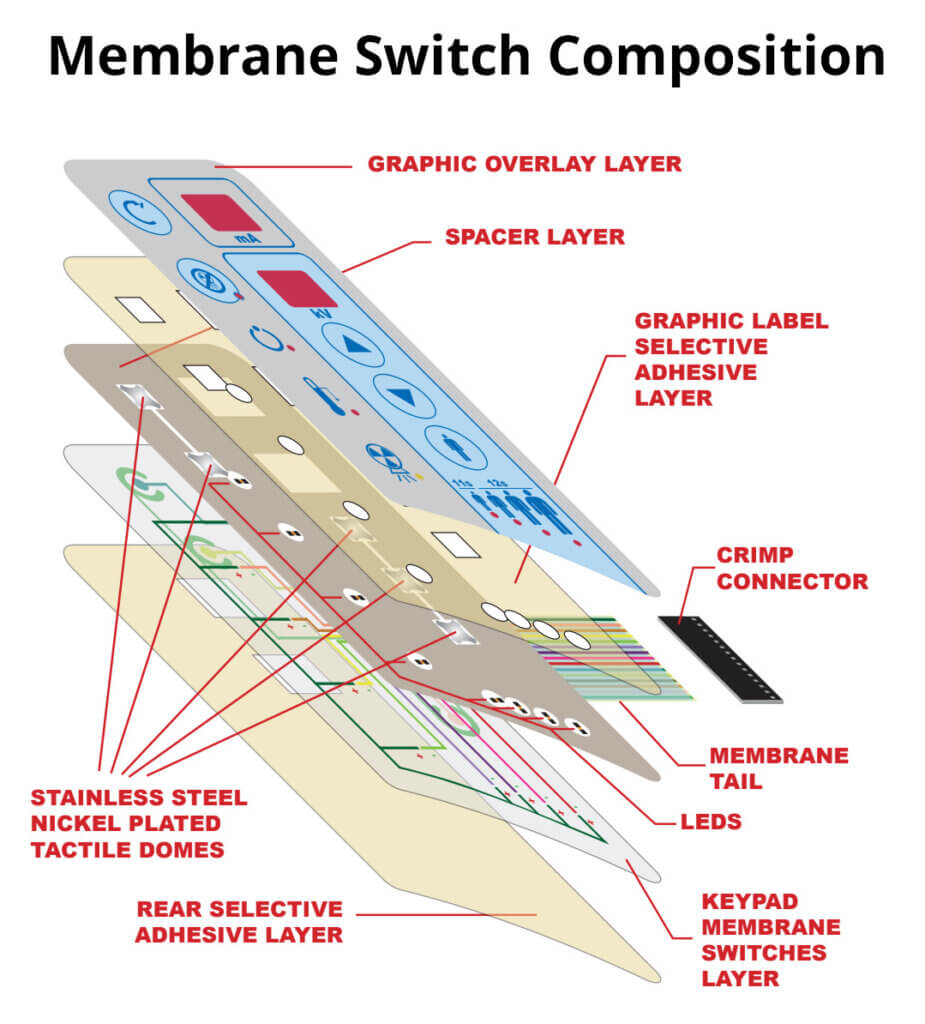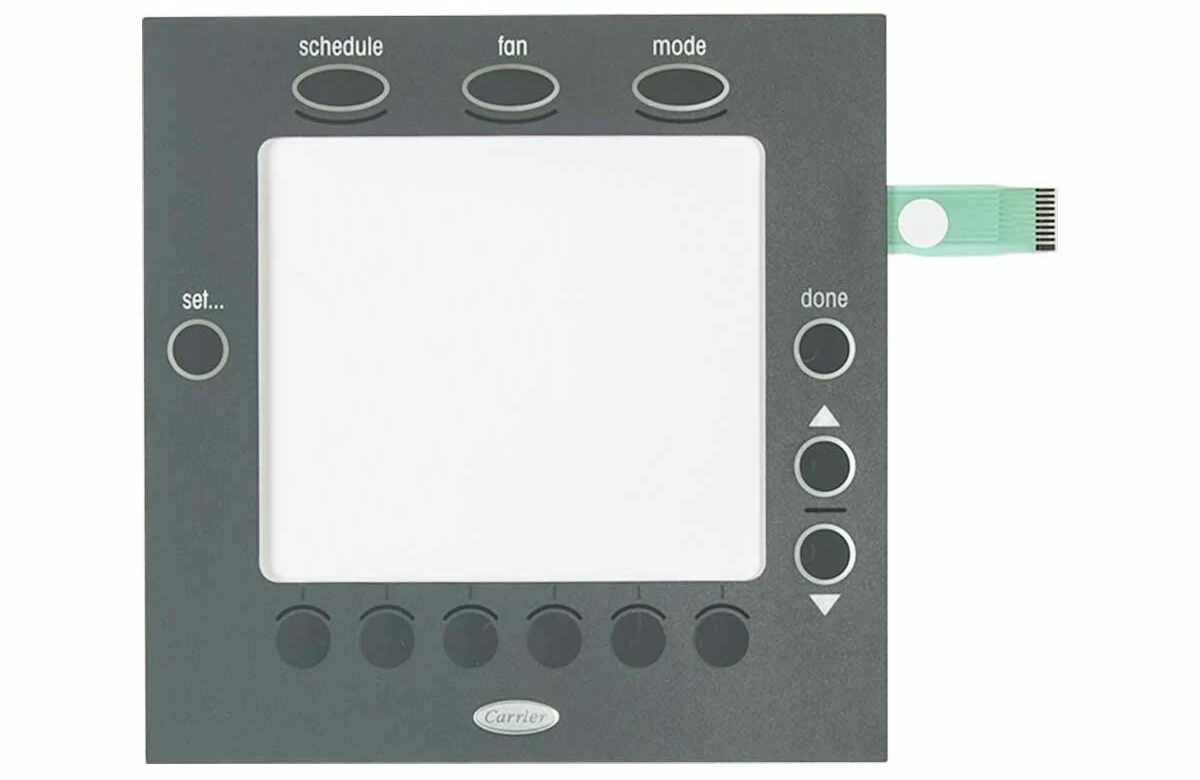Membrane Switch Manufacturer Providing Durable and High-End Interfaces
Membrane Switch Manufacturer Providing Durable and High-End Interfaces
Blog Article
Checking Out the Manufacturing Process of Membrane Switch for Different Industries
The production process of Membrane switches is a complex undertaking that requires accuracy and attention to information. From selecting appropriate materials to implementing extensive top quality control actions, each step plays an important role in making sure functionality. Numerous industries, consisting of vehicle and medical, rely upon these elements for their unique applications. Understanding the details of this procedure exposes considerable insights into just how these buttons are generated and their influence throughout varied markets.
Recognizing Membrane Switches: A Review

Secret Materials Made Use Of in Membrane Switch Production
In Membrane switch manufacturing, the choice of vital materials greatly affects capability and longevity. Conductive materials, adhesives, and finishings play crucial roles, while substrate option influences general efficiency and integrity. Understanding these elements is necessary for enhancing the style and manufacturing of Membrane buttons.
Conductive Materials Summary
Conductive materials play a crucial function in the functionality of Membrane switches, guaranteeing dependable electrical links within the tool. Generally made use of materials consist of silver, copper, and carbon-based inks, each offering unique benefits. Silver is preferred for its high conductivity and sturdiness, making it perfect for applications needing robust efficiency. Copper, while slightly less conductive than silver, is a cost-efficient alternative usually utilized in printed circuits. Carbon-based inks provide a flexible choice, appropriate for applications where versatility and lower costs are prioritized, although they have lower conductivity contrasted to steel options. The choice of conductive products straight impacts the overall dependability, life-span, and efficiency of the Membrane button, making it an essential factor to consider in the production procedure.
Adhesives and Coatings
Finishings and adhesives are vital components in the production of Membrane switches, supplying crucial bonding and safety buildings. These materials ensure that different layers of the button, consisting of visuals overlays and wiring, stick firmly to each other, boosting resilience and performance. Frequently utilized adhesives include pressure-sensitive adhesives (PSAs) and epoxy-based formulas, which provide strong bond and durability. Coatings, such as polyurethane or acrylic, serve to safeguard against environmental factors, consisting of dampness, abrasion, and chemicals. In addition, finishings can boost tactile comments and aesthetic charm, adding to the general individual experience. The choice of suitable adhesives and layers is crucial for enhancing performance and long life in varied applications throughout different industries, guaranteeing that Membrane switches meet details functional needs.
Substrate Selection Variables
Substratum choice plays a vital role in the production of Membrane switches, as it substantially affects their general performance and sturdiness. Key products such as polyester, polycarbonate, and adaptable printed circuit boards (FPCBs) are frequently used for their distinctive residential or commercial properties. Polyester is preferred for its cost-effectiveness and resistance to abrasion, making it suitable for applications with high wear. Polycarbonate deals exceptional quality and impact resistance, perfect for atmospheres calling for high exposure. FPCBs give improved adaptability and are typically utilized in complex styles. The choice of substrate also influences elements like thermal security, chemical resistance, and convenience of printing. Inevitably, choosing the ideal substrate is critical for ensuring the performance and long life of Membrane changes across different sectors.
The Design Refine of Membrane Changes
The style process of Membrane buttons is a crucial phase that significantly affects the functionality and looks of the end product - membrane switch manufacturer. It begins with defining the specific demands of the application, including measurements, switch format, and responsive feedback preferences. Designers should think about individual communication, making sure that the button is instinctive and accessible.Next, products are picked based upon durability, flexibility, and environmental resistance. The integration of graphics and branding aspects is likewise necessary, as it boosts aesthetic appeal and interaction. Prototyping enables repetitive screening, allowing modifications based on customer responses and efficiency evaluations.Additionally, the style should account for the electrical parts, such as ports and circuits, guaranteeing reliability and ease of use. Ultimately, an effective style harmonizes capability, aesthetics, and customer experience, leading the way for reliable production and lasting efficiency in different industries
Printing Strategies for Membrane Changes
The printing methods used in helpful site Membrane switch production play a crucial function in determining the end product's high quality and performance. Screen printing offers benefits such as toughness and dynamic shade application, while digital printing developments give versatility and accuracy in design. Comprehending these approaches can considerably influence the general efficiency of Membrane switches in different applications.
Display Printing Advantages
Many advantages make screen printing a favored method for creating Membrane switches. This approach enables top notch, detailed layouts and vivid colors, which are necessary for interface applications. Screen printing is specifically reliable for using thick ink layers, improving sturdiness and tactile responses. On top of that, it provides outstanding adhesion to numerous substrates, ensuring longevity popular environments. The procedure is cost-efficient for big production runs, as it reduces arrangement time and waste. Display printing sustains a wide array of inks, including specialty and UV-curable choices, enabling convenience in layout. Its capability to produce constant results across multiple systems makes it a trustworthy option for suppliers going for quality and effectiveness in Membrane switch manufacturing.
Digital Printing Innovations

Improvements in electronic printing technology are changing the manufacturing of Membrane switches, using suppliers ingenious remedies that enhance design versatility and performance. Digital printing permits for complex layouts and high-resolution graphics, enabling customized branding and performance without the limitations of conventional approaches. This technique minimizes arrangement times and costs, assisting in much shorter manufacturing runs and marginal browse around these guys waste, making it suitable for organizations with varying demands. Furthermore, advancements in ink solutions provide far better toughness and adhesion, making sure long life in numerous atmospheres. As industries progressively look for complex and tailored designs, digital printing sticks out as a necessary method, establishing a new standard in Membrane switch production. The integration of these advancements placements producers to meet advancing market needs properly.
Setting up and Layering of Membrane Switch Parts
Cautious setting up and layering of Membrane button components are vital to ensuring performance and durability. This procedure starts with the precise alignment of various layers, consisting of the graphic overlay, sticky, circuit layer, and support material. Each element must be carefully positioned to keep electrical integrity and interface responsiveness.During setting up, conductive traces are put on the circuit layer, normally made from materials like polyester or polycarbonate. This layer is essential, as it beams when pressure is used. The adhesive used for bonding these layers is additionally picked for its capability to endure ecological stresses while maintaining a safe and secure bond.Heat and pressure are usually applied throughout the setting up procedure to identify that the layers stick correctly without jeopardizing the performance of the switch. Attention is given to the edge securing to shield against dampness and impurities, safeguarding the durability of the Membrane button in various commercial applications.
Quality Control Actions in Membrane Switch Manufacturing
Quality assurance steps play a crucial role in ensuring the dependability and performance of Membrane changes complying with the setting up and layering of their components. In the manufacturing procedure, several crucial assessments are carried out to maintain quality criteria. These include aesthetic inspections for flaws in printing and adhesive application, along with useful tests to confirm the responsiveness of each switch.Additionally, ecological testing is done to evaluate the switches' durability versus temperature variations and humidity exposure. Makers commonly apply statistical procedure control (copyright) techniques to keep track of production uniformity, enabling very early detection of anomalies.Furthermore, traceability systems are developed to track materials and elements, ensuring accountability and helping with recalls if required. Calibration of equipment and adherence to market standards are also crucial to keeping item integrity. Jointly, these quality assurance steps safeguard the performance of Membrane switches over throughout different applications, inevitably enhancing customer contentment.
Applications of Membrane Switches Throughout Different Industries
Membrane switches are used across a diverse variety of industries, showcasing their flexibility and versatility. In the medical field, they supply waterproof and reputable interfaces for gadgets such as diagnostic equipment and mixture pumps, making sure hygiene and convenience of use. The auto sector utilizes Membrane buttons for dashboard controls, allowing smooth communication in between the driver and car systems.In consumer electronics, these switches are located in devices and portable devices, using a streamlined, contemporary aesthetic while improving performance. Industrial applications additionally utilize Membrane switches over for equipment control panels, where resilience and resistance to severe conditions are essential.Furthermore, the aerospace and protection fields utilize Membrane buttons for cabin instrumentation and interaction systems, prioritizing integrity and performance under extreme problems. In general, Membrane switches play a critical function in enhancing the user experience and operational performance across different domains.
Often Asked Inquiries
How much time Does It Require To Produce a Membrane Layer Switch?
The manufacturing time for a membrane layer button usually ranges from a couple of days to numerous weeks - membrane switch manufacturer. Elements affecting this period consist of layout intricacy, material availability, and production volume, all affecting the total timeline significantly
What Is the Common Lifespan of a Membrane Layer Switch?
The normal lifespan of a membrane layer switch generally ranges from 1 to 5 million actuations, depending upon variables such as material high quality, ecological problems, and usage regularity, significantly impacting sturdiness and total efficiency.
Can Membrane Changes Be Personalized for Details Applications?
Membrane buttons can indeed be customized for specific applications. Their design versatility permits for modifications in dimension, form, colors, and graphics, making certain compatibility with one-of-a-kind requirements across numerous sectors and boosting performance and customer experience.

Are Membrane Changes Eco-friendly?
The ecological influence of Membrane changes varies. Some products utilized might not be environmentally friendly, while improvements in manufacturing procedures are significantly concentrating on sustainability, intending to reduce waste and promote recyclable parts in their manufacturing.
What Are the Common Failing Modes of Membrane Switches?
Typical failure modes of Membrane check buttons consist of delamination, adhesive failure, damage from use, moisture access, and electric failures. These issues can considerably influence functionality, efficiency, and life-span in various applications across different markets. Membrane switches can be personalized to fit certain layout requirements, such as shape, performance, and size, making them highly adaptable.The construction normally includes several layers, including a visuals overlay, glue, and a circuit layer, which work together to create a seamless user experience. In Membrane switch production, the choice of essential materials considerably affects performance and sturdiness. The vehicle market utilizes Membrane switches for dashboard controls, allowing seamless communication between the driver and lorry systems.In customer electronic devices, these buttons are discovered in appliances and handheld gadgets, providing a sleek, modern-day visual while improving capability. Industrial applications additionally utilize Membrane switches for equipment control panels, where longevity and resistance to harsh problems are essential.Furthermore, the aerospace and defense sectors make use of Membrane buttons for cabin instrumentation and communication systems, prioritizing integrity and performance under extreme problems. Membrane buttons can without a doubt be personalized for certain applications.
Report this page